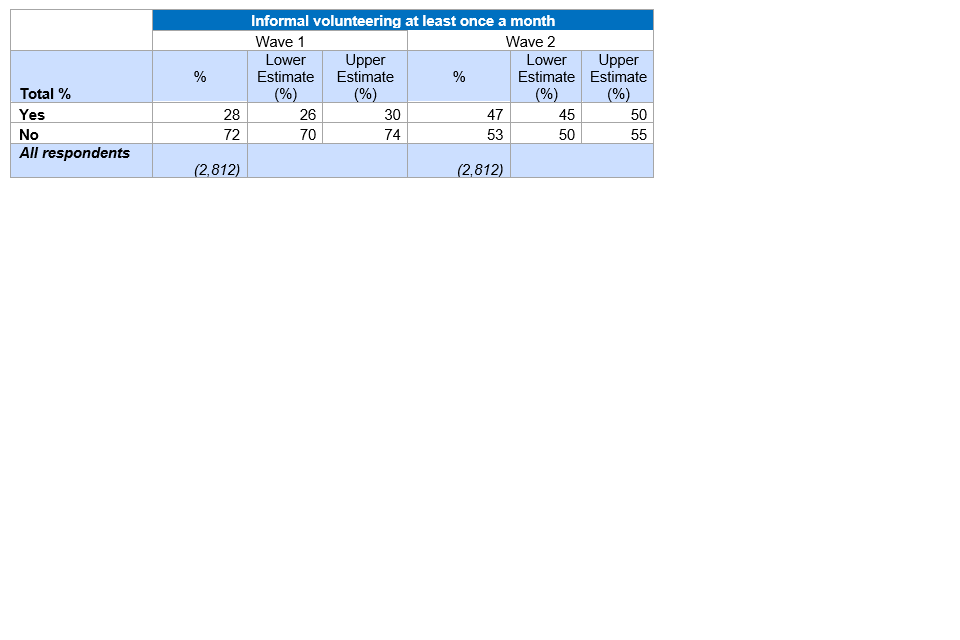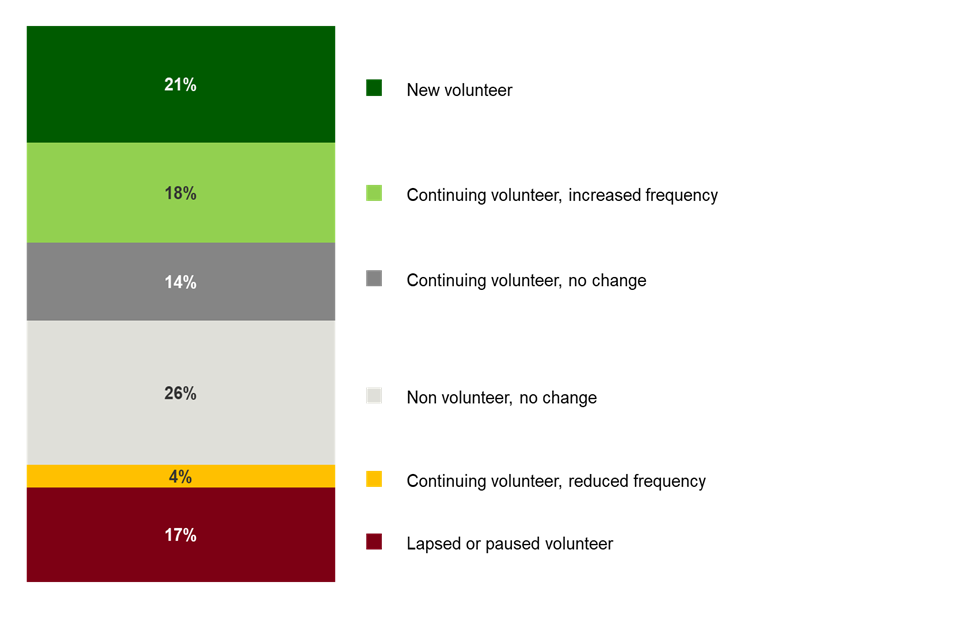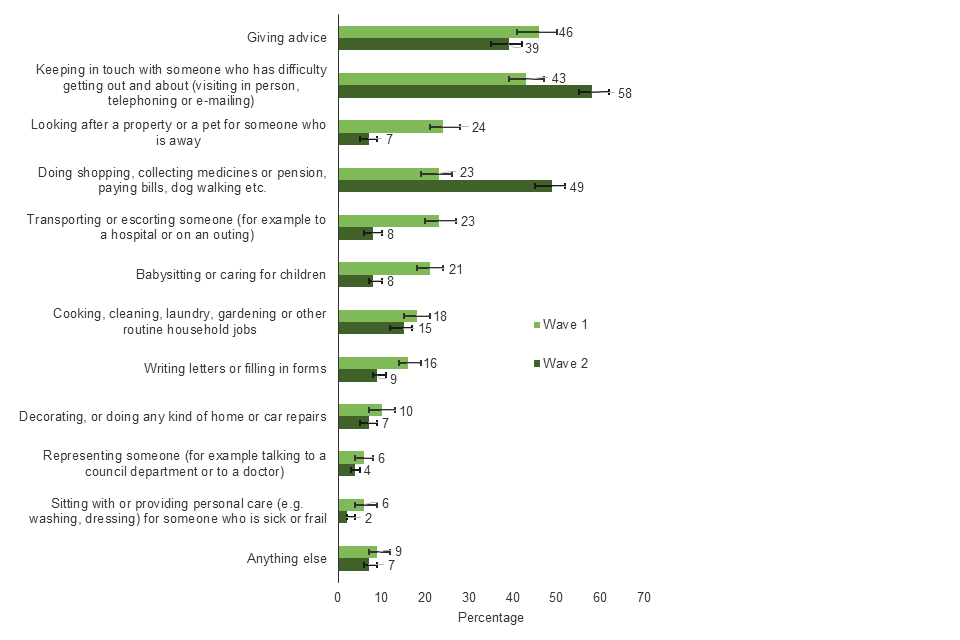4. Informal Volunteering - Community Life COVID-19 Re-contact Survey 2020
Published 8 December 2020
Applies to England
In the 2018-19 and 2019-20 Community Life Survey (referred to as wave 1) and the Community Life Re-contact Survey 2020 (referred to as wave 2), informal volunteering is defined as giving unpaid help as an individual to people who are not a relative. For example, babysitting or caring for children, keeping in touch with someone who has difficulty getting out and about, or helping out with household tasks such as cleaning, laundry or shopping.
This chapter explores the rate of informal volunteering during the four-month period following the start of the pandemic, and how the pattern of informal volunteering has changed since before the pandemic.
4.1 Interpretations and limitations
This chapter compares the prevalence of informal volunteers at wave 1 and wave 2, examining both net and gross change. Net change refers to the overall differences in rates of informal volunteering at wave 1 and wave 2, while gross change refers to change at the level of the individual (see Glossary for further details).
While all findings presented in this chapter are broadly comparable between the two waves it is important to note that the recall period differed between waves, which affects the gross change measure. As a result of this, some caution should be applied when drawing conclusions about change over time.
- As the wave 2 recall period (4 months) is shorter than the wave 1 recall period (12 months), the wave 2 survey will not capture volunteers who volunteer very infrequently, that is less than once every 4 months but at least every 12 months. This means that overall rates of informal volunteering (used in the gross change measure) cannot be compared on a like-for-like basis at wave 1 and wave 2.
4.2 How have levels of informal volunteering changed during the COVID-19 pandemic?
4.2.1 Net change in levels of informal volunteering
This section covers net changes in informal volunteering between wave 1 (before the pandemic) and wave 2 (during the pandemic).
Regular informal volunteering is defined as volunteering at least once a month.
Overall, 47% of wave 2 respondents took part in regular informal volunteering, an increase from 28% at wave 1.

The amount of time spent volunteering among regular informal volunteers was very similar. The median amount of time spent volunteering in the past 4 weeks among regular informal volunteers was 4 hours at both waves (approximately one hour per week).
Table 4.2: Number of hours spent volunteering among regular informal volunteers (net change)[footnote 1]

4.2.2 Gross change in levels of informal volunteering
Classification of gross change
Gross change refers to the change at the level of the individual (see Glossary. Given the limitations noted in section 4.1, we can only produce an approximate measure of gross change. The classification used for this analysis is summarised in Table 4.3 below.
Table 4.3: Informal volunteering - categories of gross change
Categorisation is approximate and should be interpreted with caution due to differences in the way data were collected at wave 1 and wave 2 (see section 4.1 above)
| Gross change category | Description |
|---|---|
| New informal volunteer | Did not volunteer over the 12-month period at wave 1 but did volunteer over the 4-month period at wave 2 |
| Continuing informal volunteer, increased frequency | Volunteered over a 12-month period at wave 1 and volunteered with increased frequency over a 4-month period at wave 2 |
| Continuing informal volunteer, unchanged | Volunteered over a 12-month period at wave 1 and volunteered with the same regularity over a 4-month period at wave 2 |
| Non-informal volunteer, unchanged | Did not volunteer either over the 12-month period at wave 1 or over the 4-month period at wave 2 |
| Continuing informal volunteer, reduced frequency | Volunteered over a 12-month period at wave 1 and volunteered with reduced frequency over a 4-month period at wave 2 |
| Lapsed or paused informal volunteer | Volunteered over a 12-month period at wave 1 but did not volunteer over the 4-month period at wave 2 |
In summary:
-
Overall, four in ten (40%) respondents at wave 2 had the same informal volunteering status as at wave 1: 26% remained non-volunteers while 14% took part in informal volunteering with the same frequency at both waves. This left 60% who had done either more or less informal volunteering at wave 2 compared with wave 1.
-
Breaking this down further, 39% had done more informal volunteering (21% had started volunteering during this period while 18% had continued with increased frequency) while 22% had done less informal volunteering at wave 2 (17% had stopped or paused and 4% had continued but with reduced frequency).
Figure 4.4: Changes in informal volunteering behaviour between wave 1 and wave 2 at the individual level (gross change)

Findings are approximate and should be interpreted with caution due to differences in the way data were collected at wave 1 and wave 2 (see section 4.1).
All respondents excluding don’t know and refused responses (2,760).
Who has changed their pattern of informal volunteering?
Focusing in on those who had lapsed or paused informal volunteering at wave 2, there was little variability by demographic subgroups. There was also little variability by demographic subgroups in the proportion who had started volunteering at wave 2 (‘new volunteers’), although respondents without a limiting long-term illness or disability (23%) were more likely to have started volunteering at wave 2 compared with 16% of respondents with a limiting long-term illness.
4.3 Are people doing different types of informal volunteering during the COVID-19 pandemic?
Overall, 57% of wave 2 respondents had taken part in any informal volunteering in the four months following the pandemic (March-July).
There were significant shifts in the nature of volunteering activities carried out by regular informal volunteers between wave 1 and wave 2.
At wave 2, regular informal volunteers were less likely than at wave 1 to provide help with tasks that take place in or from other people’s homes:
-
Looking after a property or pet for someone who is away (24% at wave 1 vs. 7% at wave 2)
-
Babysitting/caring for children (21% at wave 1 vs. 8% at wave 2)
-
Help with transporting or escorting someone (23% at wave 1 vs. 8% at wave 2).
Instead, wave 2 regular informal volunteers were more likely to do the following activities:
-
Keep in touch with someone who has difficulty getting out and about (43% at wave 1 vs. 58% at wave 2)
-
Shopping, collecting items, medicine or pensions, pay bills, dog walking etc. (23% at wave 1 vs. 49% at wave 2).
Figure 4.5: Ways in which regular informal volunteers have given unpaid help to individuals, not including relatives (net change)

All regular informal volunteers excluding those who gave a don’t know or refused response: Wave 1 (904); Wave 2 (1,465).
How many people have taken part in informal volunteering specifically related to helping people affected by COVID-19 or associated restrictions?
In the four months following the pandemic (March-July), three in ten wave 2 respondents (30%) had taken part in informal volunteering that was specifically related to helping people affected by COVID-19 or associated restrictions.
This means that half (52%) of wave 2 respondents who had volunteered informally in the four months following the pandemic were helping people affected by the pandemic.
Respondents who had volunteered informally since the pandemic were asked if they had started COVID-19 related informal volunteering activities after the pandemic or if they were already involved in these sorts of activities before the pandemic.[footnote 2] Overall, 72% started after the pandemic, while 28% continued doing something they were already involved in before the pandemic.
Table 4.6: When respondents started doing informal volunteering that contributed to the COVID-19 response, wave 2[footnote 3]

-
Excluding those who gave a don’t know or refused response and respondents who completed via postal questionnaire at wave 1. ↩
-
For example, a respondent may have been helping an elderly neighbour with food shopping before the pandemic and continued to provide this help during the pandemic. ↩
-
Excluding those who gave a don’t know or refused response. ↩
